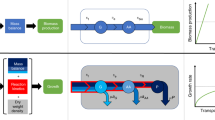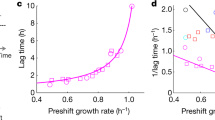Abstract
A microbial colony needs several essential nutrients in order to grow. Moreover, the colony requires these nutrients in fixed combinations, which are dictated by the chemical composition of its biomass. Unfortunately, ambient availabilities of the various nutrients vary all the time. This poses the question of how microbes can achieve balanced growth.
The present solution to this problem is novel in that the allocation of molecular building blocks among assimilatory machineries within the cell is regarded as dynamic. This paper shows that allocation can be adapted so as to achieve balanced growth, nearly regardless of environmental conditions. Moreover, it is shown that a feedback mechanism, which monitors internal stores, is able to achieve this allocation.
Similar content being viewed by others
REFERENCES
Begon, M., J. L. Harper and C. R. Townsend (1990). Ecology: Individuals, Populations and Communities. Blackwell Scientific, Cambridge, second edition.
Brock, T. D., M. T. Madigan, J. M. Martinko and J. Parker (1994). Biology of Microorganisms. Prentice-Hall International, seventh edition.
Burden, R. L. and J. D. Faires (1989). Numerical Analysis. PWS-KENT Publishing Company, Boston, fourth edition.
Hanegraaf, P. P. F., B. W. Kooi and S. A. L. M. Kooijman (2000). The role of intracellular components in food chain dynamics. Comptes Rendus de l'Académie des Sciences III 323: 99-111.
Herbert, D. (1958). Some principles of continuous culture. In: G. Tunevall (Ed.) Recent Progress in Microbiology. pages 381-396. Almquist & Wiksell, Stockholm.
Kompala, D. S., D. Ramkrishna and G. T. Tsao (1984). Cybernetic modeling of microbial growth on multiple substrates. Biotechnology and Bioengineering 26: 1272-1281.
Kooijman, S. A. L. M. (1993). Dynamic Energy Budgets in Biological Systems. Cambridge University Press, Cambridge.
Mason, C. A., G. Hamer and J. D. Bryers (1986). The death and lysis of microorganisms in environmental processes. FEMS Microbiology Reviews 39: 373-401.
Monod, J. (1942). Recherches sur la Croissance des Cultures Bactériennes. Ph.D. thesis.
Neidhardt, F. C., J. L. Ingraham and M. Schaechter (1990). Physiology of the Bacterial Cell. Sinauer, Sunderland, Massachusetts.
Pavlou, S. and A. G. Fredrickson (1989). Growth of microbial populations in nonminimal media: Some considerations for modeling. Biotechnol. Bioeng. 34: 971-989.
Pirt, S. J. (1965). The maintenance energy of bacteria in growing cultures. Proceedings Royal Society London B Biological Sciences 163 B: 224-231.
Straight, J. V. and D. Ramkrishna (1994). Cybernetic modeling and regulation of metabolic pathways. Growth on complementary nutrients. Biotechnology Progress 10: 574-587.
van den Berg, H. A. (1998a). A generic view of classic microbial growth models. Acta Biotheoretica 46: 117-130.
van den Berg, H. A. (1998b). Modelling the metabolic versatility of a microbial trichome. Bulletin of Mathematical Biology 60: 131-150.
van den Berg, H. A. (1998c). Multiple Nutrient Limitation in Microbial Ecosystems. Ph.D. Thesis, Vrijc Universiteit, Amsterdam.
van den Berg, H. A. (1998d). Multiple nutrient limitation in unicellulars: Reconstructing Liebig's law. Mathematical Biosciences 149: 1-22.
van den Berg, H. A., Y. N. Kiselev, M. V. Orlov and S. A. L. M. Kooijman. (1998). Optimal allocation between nutrient uptake and growth in a microbial trichome. Journal of Mathematical Biology 37: 28-48.
Author information
Authors and Affiliations
Rights and permissions
About this article
Cite this article
van den Berg, H.A. How Microbes Can Achieve Balanced Growth in a Fluctuating Environment. Acta Biotheor 49, 1–21 (2001). https://doi.org/10.1023/A:1010267821884
Issue Date:
DOI: https://doi.org/10.1023/A:1010267821884




